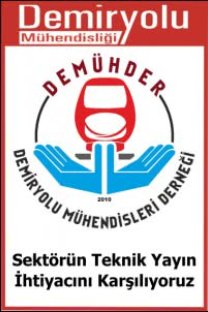Pik Döküm ve Kompozit Fren Pabucu Kullanılan Yük Vagonunda Uzun Süreli Frenlenme Sonucu Tekerlekte Açığa Çıkan Isı Dağılımının Sayısal Analiz Metodu ile İncelenmesi
The Study of Heat Distribution on Wheelsets Braked With Cast İron and Composite Brake Block by Using Numerical Analysis Method After a Long Term Tread Brake Application of a Freight Wagon
Thermal analysis, Freight wagon wheelset Tread braking, Cast iron brake block, Composite brake block,
___
[1] Ö.Akbayır, “Yük vagonlarında kullanılan sabolar ve karşılaştırması,” 1.Uluslararası Raylı Sistemler Mühendisliği Çalıştayı, Karabük, Türkiye, 2012.[2] Wheels and Wheelsets. Conditions Concerning the Use of Wheels of Various Diameters, UIC 510-2, 2014.
[3] Runaway /Derailment- Canadian, National Freight Train, Railway Investıgatıon Report R06V0136, 2006.
[4] Residual Stresses in Railroad Commuter Car Wheels, US Federal Railroad Administration, 1999.
[5] Brakes,General Conditions for Certification of Composite Brake Block, pp.26, UIC 541-4, 2007.
[6] Limites Thermiques des Roues et des Sabots , ORE B 169/RP1, 1987.
[7] R. Zima, P.J. Dvojkli, Wheelset. Bonatrans Group, 2012.
[8] D.Milutinovic, A. Radosavljevic, V. Lucanin, “Temperature and stress state of the block braked solid wheel in operation on Yugoslav Railways,” FME Transactions, vol. 31, no 1, pp. 16, 2003.
[9] R.Gallo, M. Bettineschi, F. Lombardo, G.Mancini, A.Fattori, “Effects of thermal loads on fatigue verification of wheels with web mounted brake discs,” pp.7-8, 2007.
[10] M. F. Modest, Radiative Heat Transfer. Akademic Press, 2013.
- ISSN: 2149-1607
- Yayın Aralığı: 2
- Başlangıç: 2014
- Yayıncı: Demiryolu Mühendisleri Derneği
Yatar Gövdeli Demiryolu Araç Teknolojisi ve Türkiye
Nail KARAGÖZ, Halil İbrahim ACAR
Türkiye’de Demiryolu İstasyonlarının Değerlendirilmesi İçin Analitik Hiyerarşi Süreci Uygulaması
Sinem KAYA, Fahriye MERDİVENCİ
Sezgin OZDEMIR, Bekir KESKİN, Tamer EREN, Evrencan ÖZCAN
AHP, COPRAS ve Tamsayılı Programlama Entegrasyonu ile Demiryolu Araçlarında Bakım Planlaması
Sezgin OZDEMIR, Evren Can ÖZCAN
Metro AC CER Güç Dağıtım Sistemlerinde Yük Paylaşımının Modellenmesi
Ulaştırma Sektöründe Dışsallıklar Üzerine Bir Araştırma
Yeni Nesil Çevreci Kompozit Traversler
Nail KARAGÖZ, Halil İbrahim ACAR, Burhan SELÇUK
Demiryolu Ray ve Kusurlarını Tespit Etmek İçin Geliştirilen İki Yeni Yöntem
